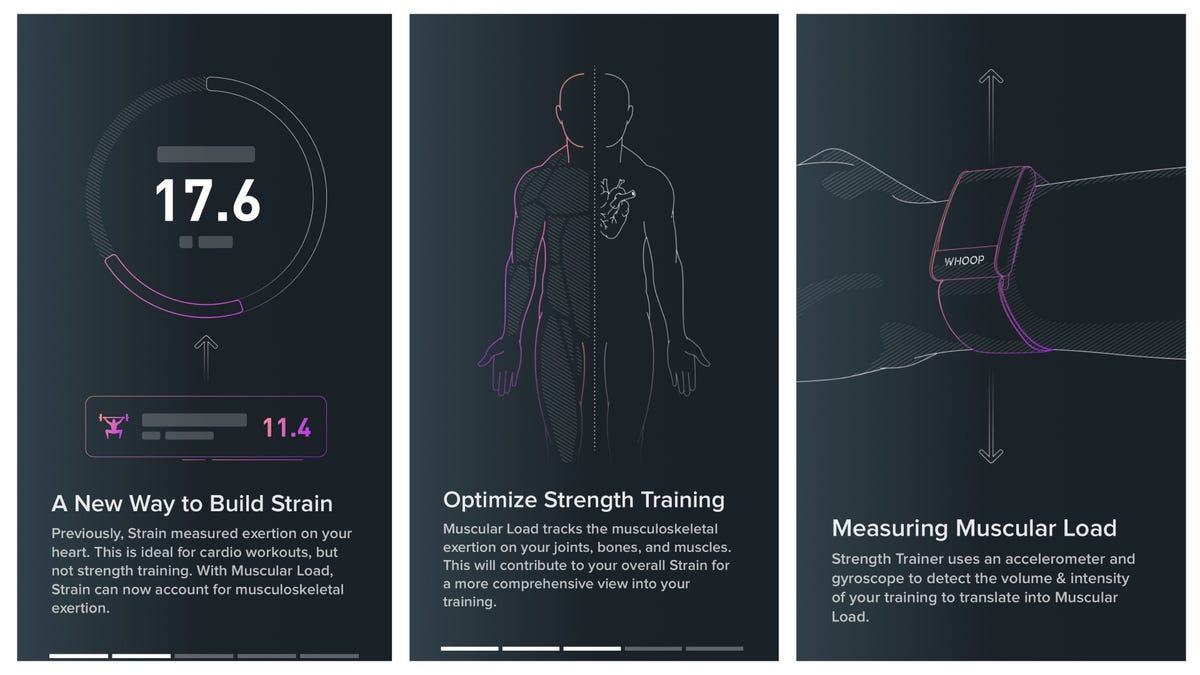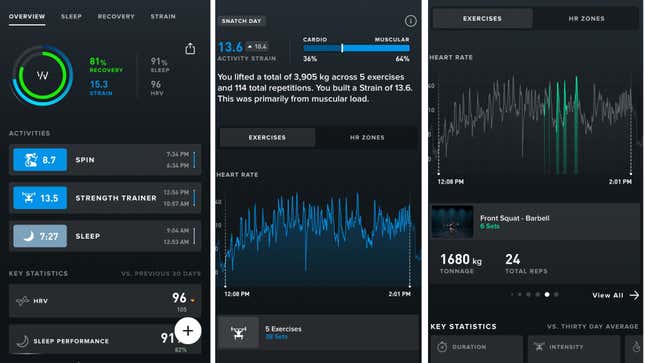Is Whoop's New Strength Trainer Worth Switching For?
Wearables that track activity have always done well with cardio. When you run or cycle, your heart rate is a pretty accurate reflection of how hard you worked. But strength training stresses your body in a very different way,...

Wearables that track activity have always done well with cardio. When you run or cycle, your heart rate is a pretty accurate reflection of how hard you worked. But strength training stresses your body in a very different way, and wearables have never really managed to get a handle on that—until, possibly, just now.
Whoop, the screenless wristband that tracks both sleep and exercise, has always had a “weightlifting” workout that you could log in much the same way as you would log a cardio session: Just hit the start button, do your thing, and get a score at the end. But it would come with a disclaimer that “your Strain [score] may be lower than your perceived effort.” In other words, they know they’re not measuring the intensity of the workout accurately.
But that’s changing. Whoop has introduced a feature called Strength Trainer, which aims to track the impact on your body of every rep of every set of every exercise. If this actually works in a useful way, it’s a huge industry first. None of the other consumer wearables on the market track strength training except by treating it as a strange flavor of cardio. (Garmin can count reps for you, though, which is cool.)
If you’re a lifter and you currently use another wearable, like an Oura or Apple Watch, such a feature might be worth switching devices for. So does it deliver on the promise?
Why wearables need to start tracking strength training
Lifting heavy takes a lot out of you. There’s the soreness many of us are familiar with, but serious lifters know that the effects of heavy lifting can go beyond that. If I max out my deadlift (keep adding weight until I literally can’t get the bar off the ground), I know not to expect too much of myself for at least a few days afterward—whether I’m sore or not.
To track your recovery from workouts, wearables usually measure something called heart rate variability (HRV). HRV measures whether your heart beats on a steady rhythm or not—the less rhythmic, the better, it turns out.
That’s helpful in knowing now recovered I am right now, but it can’t tell the difference between when a hard workout tanked my HRV but I got plenty of sleep and food so I’ve recovered well, versus when I’ve been training normally but really slacking off in the recovery department. So far, human judgment is the best gauge we have for that. My coach doesn’t need to see my HRV data to know that I’ll be fatigued toward the end of a hard training block.
In addition to HRV, recovery-oriented wearables use a variety of other metrics to tell you how recovered you are or how much recovery you need. (By “recovery,” they mostly mean sleep.) So they’ll consider how many hours you slept last night, how low your heart rate got during the night, and they may try to account for the amount of exercise you got—which is where Strength Trainer comes in.

Screenshot: Beth Skwarecki, Whoop
What it’s like to use Whoop’s Strength Trainer
The Strength Trainer lives in a different part of the Whoop app than the regular workout types. From the plus sign in the bottom right corner, you can open the Strength Trainer, and from there you can either create a workout or choose one of the pre-loaded workouts Whoop has designed.
The best thing about the workout creation tool is that it includes a huge library of exercises, about 200. I was pleasantly surprised to find a variety of Olympic lifts and their variations: snatches, power snatches, hang snatches, and hang power snatches are all in there. There’s no way to create a complex like “snatch pull + snatch,” which I hope is something they’ll add in the future. If you’re doing an exercise that’s not in the database, you have the option to add it as “Other.”
The worst thing about it—and one that is potentially a dealbreaker—is that it needs to be babysat constantly. When you create the workout, you’ll enter the exercises, sets, reps, and weight. (Reps and weight can be updated during the workout.) When you actually do the workout, the real hand-holding begins. You need to hit a button to start each set, and then tap again to end it. This means constant app-switching if you’re also using your phone for anything else, like taking videos.
And if you mess up, you’re kind of screwed. While you can add exercises or sets that you haven’t done yet, there’s no way to tell the app that you just recorded something you shouldn’t have. Here are a few of the mistakes I made that couldn’t be fixed:
I did six sets of clean-and-jerks without realizing I had accidentally selected the entry for jerks by themselves. Too late, they’re logged as jerks now. I left the set timer running after my last set of snatches, so it logged a good three minutes of me changing weights and setting up for the next exercise.I forgot to start the timer for several of my squat sets, so Whoop thinks I only did one set when I actually did five.Sometimes I would notice after a set that I hadn’t started the timer. So I’d start the timer and stop it after a few seconds to be sure that the set count would be correct. But that means that it’s logging a set of bent-over rows with the data from me just standing there for five seconds. Better or worse than skipping the set? I’m truly not sure.In total, I used Strength Trainer for a week, for a total of four weightlifting workouts, and did not manage to log a single one of them correctly.
Looking back, my data is mostly useless as a log. The visuals are cool—they show, in theory, where in your heart rate graph you did each exercise. But due to the mistakes above, some are mislabeled, some are the wrong number of sets, and some are “Other,” leaving me no clue of what that exercise was supposed to be. (You can’t label the “other” exercises, although that’s a feature users have been loudly requesting, so we can hope it’s coming soon.)
Cool data, but is it useful?
The Strength Trainer does one thing correctly: It gives you a higher Strain score for workouts done with the feature than for weight workouts logged the old way. I spoke with a few Whoop users who confirmed they saw higher scores than usual when they used the new feature, and several Reddit threads confirm that this is a thing people are seeing pretty consistently. (Some are even concerned the new strain scores might be too high.)
I didn’t find a drastic difference. I did my Thursday clean and jerk workout one week with the Strength Trainer and once without; I got a Strain of 10.6 with the Strength Trainer compared to 9.9 when logging it the old way. I also got some odd results from the feature that tells you what percentage of your workout was “muscular” versus just cardio. Here are the three full-length workouts I did, each of them involving heavy lifts with several-minute-long rest periods in between:
10.6 Strain, 0% (!) muscular load (jerks, clean and jerks, clean pulls, and an accessory circuit, 1 hour and 17 minutes in total)13.5 Strain, 47% muscular load (snatches, power cleans, squats, presses, rows, about two hours)13.6 Strain, 64% muscular load (snatch balance, power snatches, deadlifts, front squats, 1:53)Clearly something isn’t right here, but I can’t tell whether the low percentages are an inherent flaw of the app or if they’re because of my screwups in recording the session (which I would argue is also a flaw of the app, even if it’s technically my fault).
Many Whoop users who are lifters find the higher, and presumably more accurate, Strain to be worth the hassle of tracking workouts this way, but conversations about the feature tend to turn into wishlists: I wish I could edit workouts after I finish them. I wish I could add notes, or RPE, or 1RM. I wish it could sync with the app I’m already using to track strength workouts.
Perhaps most disappointingly, even though you have to wear the band during your workouts, wearing the band doesn’t actually help you log any of the information that the Strength Trainer requires you to enter. It doesn’t count reps for you, and it doesn’t automatically detect when you start doing an exercise. Whoop’s CTO said in a podcast that “the roadmap [of future features] on Strength Trainer is one of the richest” in the company—so they know they have work to do.
The Strength Trainer is half-baked, but something good might be cooking
If this were all the Strength Trainer ever amounted to, it would be a joke. I need to painstakingly feed it all my reps, sets, and weights, and tap a button 40+ times each workout, just to get a few points added to my Strain score, which is already an arbitrary and imprecise metric? Not worth it.
But there is almost certainly more behind the tech than what is currently available. Whoop acquired a company called Push in 2021, and used their technology to build the Strength Trainer. Push was a wrist strap device meant to help coaches train athletes with velocity-based training (VBT).
VBT involves placing a device on the weight you’re lifting—or, in Push’s case, on either the weight or your wrist—to measure how fast you move the weight. If you can move a heavy weight quickly, that means it’s easy for you at that moment. The bar will slow down as you get closer to failure in a lift, and it will also be slower (at the same weight) on days you’re more fatigued.
It’s the technological version of a coach watching you lift and deciding to add weight if your squats are “moving well,” or advising you to do a bit less work on a day when things feel harder. Before Whoop acquired it, Push promised athletes “real-time feedback” on their lifts using the sensor and a connected app, and their website assured coaches that workouts are “automatically logged.” (The exercise library also included “400+” moves, more than double what Whoop’s Strength Trainer launched with.)
According to a snippet of a Push blog archived here, the app “made recommendations for which load to use during resistance training to achieve specific adaptations based on the speed of the lift.” In other words, watching the bar like a coach would, and telling you what to do.
On the other hand, Whoop’s design choices might prevent the Strength Trainer from ever being useful
I’m both intrigued by the possibilities that the Strength Trainer presents, and pessimistic that Whoop will ever manage to do anything cool with it. Whoop bought Push, but that doesn’t mean Whoop is Push. Whoop’s marketing materials seem to be carefully avoiding using the word “velocity” at all (it’s “explosiveness” or “using the accelerometer and gyroscope sensors”), and they definitely don’t call their new offering VBT.
When I sent Whoop detailed questions about whether and how the Strength Trainer uses velocity data, I received vague answers like “It uses accelerometer and gyroscope sensors in the device to calculate the effective volume for each repetition of each exercise, measure the intensity for each repetition of each exercise, estimate max volume based on workout history, and take the max intensity for each exercise from performance profiles to calculate your unique and specific muscular load for every workout in the app.”
That’s not very impressive considering that reps and sets are entered by the user; volume can be calculated by those numbers. In the regular strength training world, intensity refers to the weight on the bar, which the user also enters. In other words, a simple spreadsheet could do all of the things that Whoop says its accelerometers and algorithms are doing. (And I can enter my one-rep-max into a spreadsheet for a more accurate measure of intensity; Whoop prefers to guess at how strong I am rather than ask me directly.)
So what is the Strength Trainer even doing? That’s honestly still unclear. Instead of building toward a VBT app—which would be cool even if it doesn’t change your recovery scores—Whoop seems to have chosen to use velocity data in a completely different way. A Whoop spokesperson said in a Reddit AMA that they consider a heavy load moved quickly to produce a high strain; that sounds backwards from how VBT usually works.
Consistent with that, a help screen in the app says that intensity “is a measure of how explosively you perform each movement.” As the term is normally used, if my best squat is 100 kilos, and I’m doing 90 today, I would call that a high intensity lift. Whoop would notice that the bar is moving slowly, and call it low intensity. That’s backwards for sure.
The other difference between a VBT system like Push and something like Whoop is that VBT is a tool you use to implement a training program. You use velocity to determine what weight will give you the desired stimulus for the day’s training. But somewhere a coach has to decide what the desired stimulus is for that training, based on your goals for your current training block. That means that if you’re doing this with an app, the app’s job is to tell you what to do.
Whoop and other consumer wearables, in trying to be everything for everyone, don’t seem to have any interest in directing your training. They also operate in the short term, rather than understanding where you are within a training block or season. As I described here, they want to tell you how much to exercise today based on how much sleep you got last night. They don’t know that you’re eight weeks out from a competition and that your coach thinks you should be training at 70% to 80% intensity today.
Whoop does have a platform for coaches to manage teams of athletes, and optimistically, I could see Whoop integrating Push-style coaching into that somehow. (In the Reddit AMA, a Whoop spokesperson said that the company is “looking at” implementing VBT-based coaching.) But for the moment, as an individual just trying to get a workout in, Whoop’s strength trainer is a clunky mess with no clear payoff for the user.

 UsenB
UsenB 
































